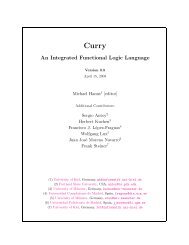Conformal Geometric Algebra in Stochastic Optimization Problems ...
Conformal Geometric Algebra in Stochastic Optimization Problems ...
Conformal Geometric Algebra in Stochastic Optimization Problems ...
You also want an ePaper? Increase the reach of your titles
YUMPU automatically turns print PDFs into web optimized ePapers that Google loves.
34 CHAPTER 2. GEOMETRIC ALGEBRA<br />
In carry<strong>in</strong>g over the previous result to the case f(ev(1),ev(2),...,e v(k)) one obta<strong>in</strong>s<br />
f(ev(1),ev(2),...,e v(k)) = c �<br />
σ∈S(k)<br />
= c �<br />
=<br />
⎛<br />
σ∈S(k)<br />
⎝c �<br />
σ∈S(k)<br />
sgn(σ)e v(σ(1))e v(σ(2)) ...e v(σ(k))<br />
�<br />
�<br />
sgn(σ) sgn(σ)ev(1)ev(2) ...e v(k)<br />
sgn(σ) 2<br />
⎞<br />
⎠ e v(1)e v(2) ...e v(k)<br />
= � ck! � e v(1)e v(2) ...e v(k) , c > 0. (2.29)<br />
Notice that e v(1)e v(2) ...e v(k) represents an ordered basis blade due to the def<strong>in</strong>ition<br />
(2.25) of v. The expression for f ultimately becomes<br />
f(a1, a2,...,ak) = � ck! � �<br />
v∈I k/n<br />
det(A|v) e v(1)e v(2) ...e v(k) , c > 0.<br />
Consequently, the outer product is uniquely def<strong>in</strong>ed up to a positive constant c ∈ �.<br />
Regard<strong>in</strong>g the outer product of basis vectors <strong>in</strong> equation (2.29) it is sensible to set<br />
the factor c to c := 1/k!. The function f can now be replaced with the fully<br />
determ<strong>in</strong>ed outer product, symbolized by � . Let<br />
� (a1,a2,...,ak) := a1 ∧ a2 ∧ ... ∧ ak =:<br />
k�<br />
aj .<br />
Then the def<strong>in</strong>itions for the outer product of k vectors a1, a2, ..., ak are<br />
� (a1, a2,...,ak) := 1<br />
k!<br />
and � (a1, a2,...,ak) := �<br />
with<br />
�<br />
σ∈S(k)<br />
v∈I k/n<br />
j=1<br />
sgn(σ)a σ(1)a σ(2) ...a σ(k)<br />
(2.30)<br />
det(A|v) e v(1)e v(2) ...e v(k) , (2.31)<br />
I k/n := {(v1,v2,...,vk) | 1 ≤ v1 < v2 < . .. < vk ≤ n} .<br />
Note that the application of equation (2.30) to the outer product of mutually different<br />
basis vectors, say ei1 ∧ei2 ∧... ∧eir, <strong>in</strong> conjunction with the rule eiej = −ejei,<br />
i �= j, immediately yields<br />
ei1 ∧ ei2 ∧ ... ∧ eir = ei1 ei2 ...eir . (2.32)<br />
Besides, by means of the associativity of the outer product it is<br />
(ei1 ei2 ...eir) ∧ (ej1 ej2 ...ejs) =<br />
(ei1 ∧ ei2 ∧ ... ∧ eir) ∧ (ej1 ∧ ej2 ∧ ... ∧ ejs) =<br />
ei1 ∧ ei2 ∧ ... ∧ eir ∧ ej1 ∧ ej2 ∧ ... ∧ ejs =<br />
ei1 ei2 ...eirej1 ej2 ...ejs ,
















